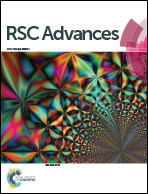High lithium ion battery performance enhancement by controlled carbon coating of TiO2 hierarchically porous hollow spheres†
Abstract
Hierarchically porous TiO2/carbon hollow spheres (TiO2/C-HS) have been designed and prepared through a facile one-pot template-free hydrothermal route using sucrose as a carbon source, TiO2 solid spheres as a TiO2 source and NH4F as a structure-directing reagent. The nanocrystal constructed hierarchically porous hollow spherical structure offers enough space for electrolyte penetration and storage and a short path length for Li+ diffusion and e− transport. The carbon layer on TiO2 surface improves its conductivity as well as the structure stability. As a result, such a special hollow structure with carbon layers exhibits enhanced lithium storage properties comparing with the solid spheres. The TiO2/C-HS anode exhibits discharge capacities of 286, 235, 197, 164 and 127 mA h g−1 at various rates of 0.2, 0.5, 1, 2 and 5C (1C = 168 mA g−1), respectively. A capacity of 175 mA h g−1 still remains after 200 cycles at 1C, demonstrating a very high lithium insertion coefficient of 0.52, a little higher than the theoretical value of 0.5. SEM, TEM, HRTEM and electrochemical impedance spectra (EIS) techniques have been utilized to understand the Li+ insertion process and structural stability. Our results reveal that the high electrochemical performance of the TiO2/C-HS anode can be attributed to the synergy of the hierarchically porous hollow structure, carbon layer and newly formed numerous ∼5 nm Li2Ti2O4 on the surface of the TiO2 nanocrystals.


 Please wait while we load your content...
Please wait while we load your content...